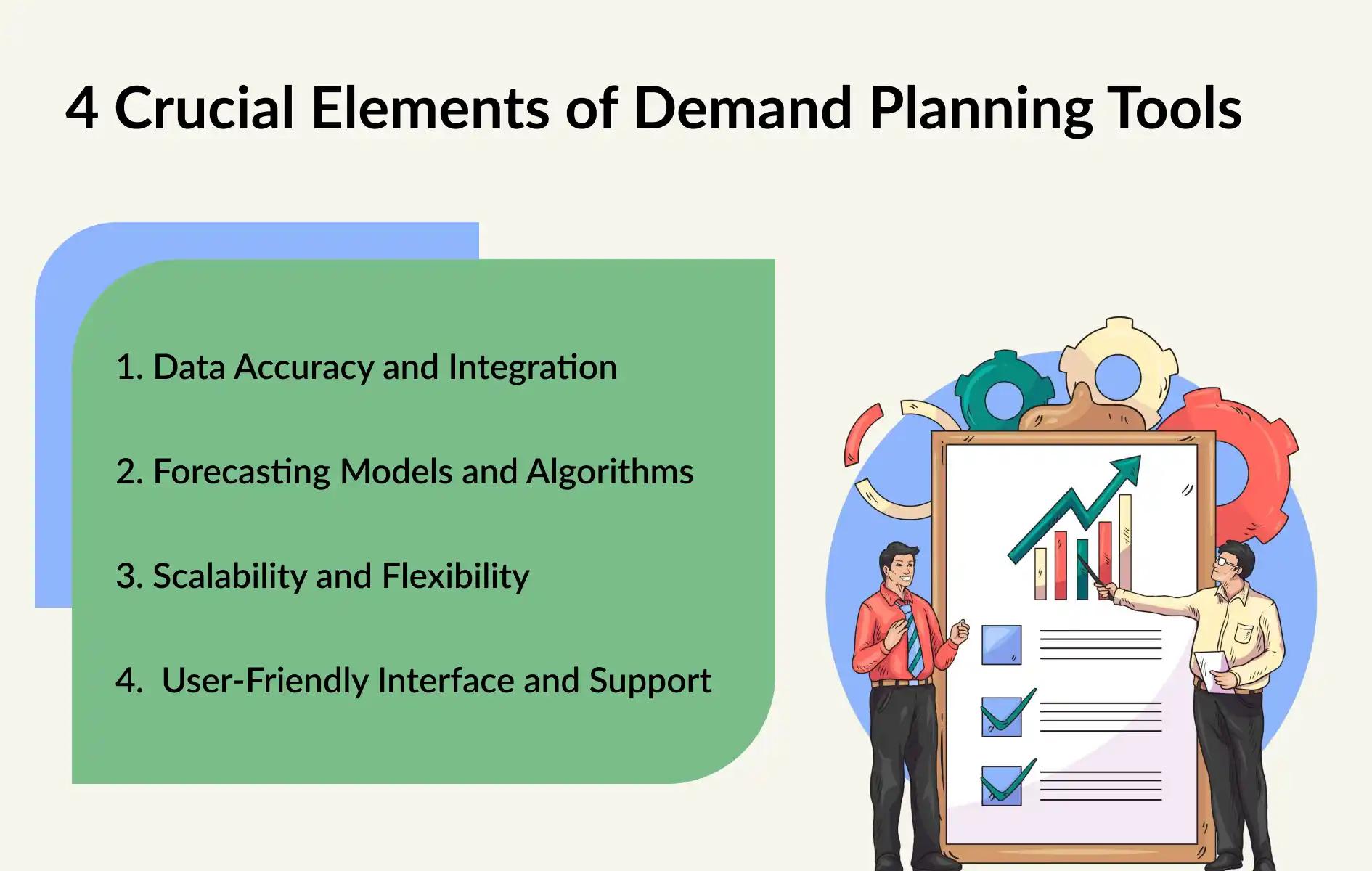What are the 4 Crucial Elements of Demand Planning Tools? | thouSense

Efficient demand planning allows businesses to anticipate customer needs with precision, ensuring sustained high levels of customer satisfaction. By accurately forecasting product demand and timing, companies can optimize inventory levels, preventing both stockouts and excess inventory. This approach not only streamlines operational efficiency but also strengthens customer loyalty by consistently meeting demand expectations and delivering a reliable service experience.
When considering the adoption of a demand planning tool, it is crucial to assess its effectiveness by focusing on four key elements. These essential factors are data accuracy and integration, forecasting models and algorithms, scalability and flexibility, and a user-friendly interface with support. By carefully evaluating these aspects, you can ensure the tool provides accurate insights and reliable forecasts, empowering your business to make informed decisions. A demand planning tool that excels in these areas will not only improve operational efficiency but also drive better business outcomes through enhanced decision-making capabilities.
Understanding Demand Planning
Demand planning is the process businesses use to forecast customer demand for products. It involves analyzing historical sales data, and market trends, and considering factors such as seasonality and special promotions. By accurately predicting future demand, businesses can ensure they have the right stock to meet customer needs while minimizing excess inventory. This proactive approach helps prevent stockouts and reduces the risk of overstocking, leading to more efficient operations and improved customer satisfaction.
4 Crucial Elements of Demand Planning Tools

When selecting a demand planning tool, it's vital to focus on four critical elements that determine its overall effectiveness. By emphasizing those elements, businesses can ensure they select a demand planning tool that supports efficient decision-making and long-term success.
1. Data Accuracy and Integration
Accurate data forms the foundation of any effective demand planning tool, as it directly influences the reliability of forecasts. When businesses rely on inaccurate or outdated information, the resulting decisions can disrupt the entire supply chain, leading to inefficiencies, missed opportunities, and reduced customer satisfaction. Therefore, ensuring data integrity is essential for maintaining operational resilience and making informed, strategic decisions.
Seamless data integration across platforms like Enterprise Resource Planning and Customer Relationship Management systems is essential for more reliable forecasts. Demand planning tools must integrate well with these systems. More likely to pull accurate and real-time data from multiple sources. This integration allows for a holistic view of the business. It provides a more comprehensive understanding of customer behavior, sales patterns, and inventory levels. Without proper integration, data silos can develop, leading to incomplete or misleading insights.
Key aspects to look for in data accuracy and integration:
● Real-time data synchronization:
The tool should be capable of syncing data in real-time across all platforms. In order to ensure forecasts are always based on the latest information.
● Compatibility with existing systems:
Seamless integration with current ERP, CRM, and other systems is crucial for minimizing data discrepancies and enhancing data flow.
● Data cleansing capabilities:
The tool should have robust data cleansing features. Additionally, it must recognize and automatically fix mistakes, duplicate entries, and inconsistencies. While ensuring data quality is maintained.
2. Forecasting Models and Algorithms
Robust forecasting models are the foundation of effective demand planning. These models help businesses predict future demand based on historical data and market trends. The more sophisticated and accurate the forecasting models are, the better equipped a business will be to predict demand changes and respond faster.
Different industries need different algorithms for accurate demand forecasting. Algorithms could be useful in businesses where demand fluctuates seasonally, for example. similar to exponential smoothing or ARIMA (AutoRegressive Integrated Moving Average). In contrast, sectors with less predictable demand may rely more on machine learning or AI-based models. As that can adapt and learn from new data patterns over time. The ability to choose and customize forecasting models based on business needs is crucial.
Key aspects to evaluate in forecasting models and algorithms:
● Capacity to adjust to demand patterns and seasonal trends:
The tool should offer algorithms that can adjust to various demand patterns. Such as including seasonal fluctuations and market trends.
● Machine learning or AI-based forecasting features:
Advanced tools use machine learning and AI to improve forecast accuracy. While learning from new data and refining predictions.
3. Scalability and Flexibility
A demand planning tool should be scalable and flexible enough to grow alongside your business. As companies expand, their data volume increases and their forecasting needs become more complex. A scalable tool ensures the system can handle larger datasets without compromising performance. This scalability is vital for companies basically for those companies that foresee rapid growth or expansion into new markets.
Flexibility is equally important in adjusting to market changes or company growth. The tool should allow businesses to modify forecasting models like adding new data sources, or changing parameters as needed. This modification should be done without requiring significant overhauls or additional investments.
Important features to consider for scalability and flexibility:
● Cloud-based vs. on-premise options:
Cloud-based tools offer easier scalability and lower upfront costs. On the other hand, on-premise options offer more security and control.
● Customizable dashboards and reports:
The ability to tailor dashboards and reports to specific needs allows teams to focus on the most relevant data and insights.
● Capacity to handle increased data as the business expands:
The tool should efficiently manage larger datasets, ensuring smooth performance and it should provide accurate forecasts even as the company grows.
4. User-Friendly Interface and Support
A user-friendly interface is crucial for the widespread adoption of any demand planning tool within a company. If a tool is difficult to navigate or requires extensive training, it can lead to inefficiencies and increased training costs. A simple, intuitive design allows all team members, regardless of their technical expertise, to use the tool effectively.
Key features to check for a user-friendly interface and support:
● Intuitive navigation and design:
The tool should be easy to use, with a clear and logical layout that minimizes the need for extensive training.
● Comprehensive support and training resources:
Access to a robust support system, including online help, tutorials, and customer service is much needed. As it ensures users can resolve any issues faster.
● Mobile accessibility:
The ability to access the tool via mobile devices allows users to make informed decisions anytime and anywhere. This improves agility and responsiveness.
Consider these critical factors—data accuracy and integration, robust forecasting models, scalability, and a user-friendly interface. This will help businesses select a demand planning tool that meets their needs. And will enhance its efficiency, and support long-term growth.
For a solution that covers all these bases, look no further than thouSense. Our platform is made to work in sync with the systems you already have. It provides powerful forecasting capabilities and scales effortlessly as your business grows. With thouSense, you gain the tools to make smarter decisions, improve collaboration, and stay ahead in a competitive market.
Conclusion
In this blog, we covered four essential key elements of effective demand planning tools. By leveraging these components, businesses can improve their demand planning and can effortlessly operate and serve better to meet customer needs. Adopting these practices can reduce costs and enhance customer satisfaction. Also, it will help companies get that extra edge to stay competitive in the market.
Looking for the best demand planning tool? thouSense can help you. To use demand planning tools efficiently, show your trust in thouSense. We provide complete help and assist you through the process seamlessly. Choose thouSense and always stay ahead of your competitors in the changing world.